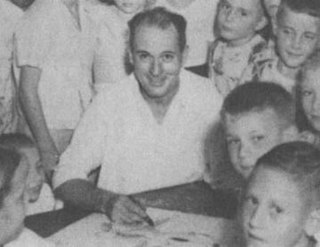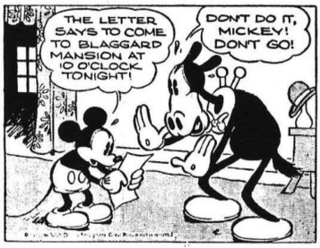
Pluto is an American cartoon character created by the Walt Disney Company. He is a yellow-orange color, medium-sized, short-haired dog with black ears. Unlike most Disney characters, Pluto is not anthropomorphic beyond some characteristics such as facial expression. He is Mickey's pet. Officially a mixed-breed dog, he made his debut as a bloodhound in the Mickey Mouse cartoon The Chain Gang. Together with Mickey Mouse, Minnie Mouse, Donald Duck, Daisy Duck, and Goofy, Pluto is one of the "Sensational Six"—the biggest stars in the Disney universe. Though all six are non-human animals, Pluto alone is not dressed as a human.

Charles Alfred "Al" Taliaferro, was an American Disney comics artist who produced Disney comic strips for King Features Syndicate. Taliaferro is best known for his work on the Donald Duck comic strip. Many of his strips were written by Bob Karp.

Theodore H. Osborne was an American writer of comics, radio shows and animated films, remembered for his contributions to the creation and refinement, during the 1930s, of Walt Disney cartoon characters.

Minnie Mouse is an American cartoon character created by the Walt Disney Company. As the longtime sweetheart of Mickey Mouse, she is an anthropomorphic mouse with white gloves, a red or pink bow, blue polka-dotted dress, white bloomers and yellow low-heeled shoes occasionally with ribbons on them.

Horace Horsecollar is a cartoon character created in 1929 at Walt Disney Animation Studios. Horace is a tall anthropomorphic black horse and is one of Mickey Mouse's best friends. Characterized as a boastful show-off, Horace served as Mickey’s sidekick in Disney's early black-and-white shorts.
Disney comics are comic books and comic strips featuring characters created by the Walt Disney Company, including Mickey Mouse, Donald Duck and Scrooge McDuck.
The Our Gang personnel page is a listing of the significant cast and crew from the Our Gang short subjects film series, originally created and produced by Hal Roach which ran in movie theaters from 1922 to 1944.

A topper in comic strip parlance is a small secondary strip seen along with a larger Sunday strip. In the 1920s and 1930s, leading cartoonists were given full pages in the Sunday comics sections, allowing them to add smaller strips and single-panel cartoons to their page.
Donald Duck, a cartoon character created by the Walt Disney Company, is today the star of dozens of comic-book and comic-strip stories published each month around the world. In many European countries, Donald is considered the lead character in Disney comics, more important and beloved than Mickey Mouse.

Kalle Anka & C:o is a Swedish weekly Disney comics magazine, published by Egmont. The 52-page comic, launched in September 1948, is the overall best-selling Swedish comic magazine. In the early years, the comic printed translated stories from the United States, including Walt Disney's Comics and Stories, Four Color and other Dell Comics Disney titles. As Disney comics production waned in the United States in the 1960s, Kalle Anka began printing more European-produced content, from Scandinavia and Italy. Now, Kalle Anka & C:o and its Scandinavian sister editions Anders And & Co. (Denmark) and Donald Duck & Co (Norway) are identical, apart from the language.
Pip, Squeak and Wilfred was a British strip cartoon published in the Daily Mirror from 1919 to 1956, as well as the Sunday Pictorial in the early years. It was conceived by Bertram Lamb, who took the role of Uncle Dick, signing himself (B.J.L.) in an early book, and was drawn until c. 1939 by Austin Bowen Payne, who always signed as A. B. Payne. It concerned the adventures of an orphaned family of animals. Pip, who assumed the father role, was a dog, whilst the 'mother', Squeak, was a penguin. Wilfred was the 'young son' and was a rabbit with very long ears.

Mickey Mouse is a Disney comic book series that has a long-running history, first appearing in 1943 as part of the Four Color one-shot series. It received its own numbering system with issue #28, and after many iterations with various publishers, ended with #330 from IDW Publishing.
Japhet and Happy was a British newspaper cartoon strip originally appeared as 'The Adventures of the Noah Family' initially in The Daily News during 1919 and transferred in 1930 to the News Chronicle. It was originated and drawn by J. F. Horrabin, James Francis Horrabin (1884–1962) who was a British journalist, cartoonist and cartographer, and he was elected Labour Member of Parliament for Peterborough from 1929 to 1931. He wrote Political books as well as the 'Dot and Carrie' strip for The Star that ran from 1922 to 1964. The Noah Family names are based on religious names, but the cartoon strips have no religious theme.
Teddy Tail was a British newspaper comic strip about a cartoon mouse featured in The Daily Mail from 5 April 1915. It was the first daily cartoon strip in a British newspaper, The character survived until the 1960s with several artists drawing newspaper strips and the varied annuals. Such was his popularity that other newspapers created their own cartoon characters, the Daily Express with Rupert Bear and the Daily Mirror with Pip, Squeak and Wilfred.
Fred Spencer was an American animator who worked at Walt Disney Productions. He was considered an authority on Donald Duck and wrote an influential analysis of the character.
Mickey Mouse Weekly is a 1936–1957 weekly British tabloid Disney comics magazine, the first British comic with full colour photogravure printing. It was launched by Willbank Publications and later continued by Odhams Press. The comics were said to be "drawn in a slick, smooth style which was clearly influenced by American comics."

Mickey Mouse is an American newspaper comic strip by the Walt Disney Company featuring Mickey Mouse and is the first published example of Disney comics. The strip debuted on January 13, 1930, and ran until July 29, 1995. It was syndicated by King Features Syndicate until 1990, when Disney switched to Creators Syndicate, which distributed the strip until 2014.

Mickey Mouse Magazine is an American Disney comics publication that preceded the popular 1940 anthology comic book Walt Disney's Comics and Stories. There were three versions of the title – two promotional giveaway magazines published from 1933 to 1935, and a newsstand magazine published from 1935 to 1940. The publication gradually evolved from a 16-page booklet of illustrated text stories and single-page comic panels into a 64-page comic book featuring reprints of the Mickey Mouse and Donald Duck comic strips.

Gazetka Miki was a short lived weekly children's comic first published in 1938 in inter-war Poland. The publication was the first Mickey Mouse comic produced in Poland.










